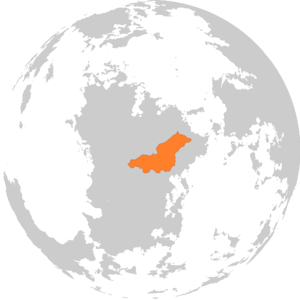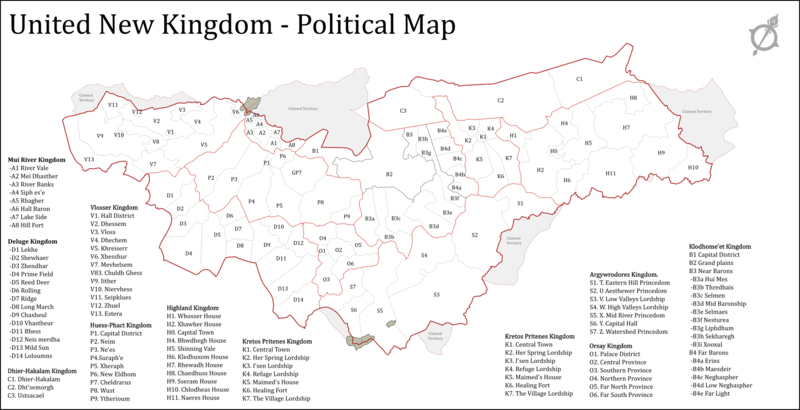United New Kingdoms
| United New Kingdoms Leh1gnewos h3regtom | |
| Flag | Coat of arms |
|---|---|

|

|
| Motto: "Through Adversity and blood to the end times" | |
| Anthem: Song of Anaria | |
| Locator map | |

| |
| Capital city | Rhagher |
| Largest city | Rhagher |
| Official language | Wolgos |
| Other languages | Regional dialects |
| Ethnic group | Wolgos - Other |
| Religion | Dlroch'veldr |
| Demonym(s) | Leh1gnewos Wolgos |
| Government | |
| Government Type | Federated kingdoms |
| h1legh3regs (Elected King) | Wednus Wednusunus of the H2wednus tribe, of the Dhegwhomnis clan |
| kaputmedhu (Chancellor) | H1eyros Weyrosunus of the H2r̥tkos tribe, of the Seh2ulyu clan |
| Legislature | Hall of Unity |
| Establishment | |
| Collapse of the Bind | 7603 CE |
| Area | |
| Total | 1,896,845.54 km2 |
| Water % | 5.0% |
| Population | |
| Total | 8,686,225 |
| Density | 4.58/km2 |
| Economy | |
| Economy type | Capitalist |
| GDP (total) | Ꞡ 20,469,709,187 |
| GDP per capita | Ꞡ 2,356 |
| Currency | UNK Vork () |
| Inequality index | 25.5 |
| Development index | 0.875 |
| Other information | |
| Time zone | -11 and -10 |
| Driving side | right |
| Calling code | tbc |
| Internet code | n/a |
| Nation number | 164 |
The United New Kingdoms, a nation forged from the remnants of Wolgos, is nestled in the Divine Rise Highlands. Originally known as the New Kingdoms, this region was once a semi-autonomous province of the now-defunct Bind, inhabited by ancient aristocratic and orthodox clans from old Dhonowlgos. Following the collapse of the Bind, the province declared independence, severing ties with the New Xedun regions and Kalsulan, whose populations were driven into exile in Kupeya. Fortuitously situated in defensible highlands and insulated from the chaos that consumed the Bind, this region avoided the widespread massacres that afflicted the Wolgos people at the hands of both subjugated populations and foreign armies. Transitioning from a remote area to a sanctuary, it provided refuge to hundreds of thousands of Wolgos fleeing from the genocides in the Nuss Plains and the Prosperity Gulf coasts.
For decades, the United New Kingdoms weathered frequent invasions from the nascent Erakr and Ak'lam nations and the peacekeeping forces of Kamuran. Encircled by adversity and dedicating all resources to survival, the nation endured a prolonged period of isolation, surviving through smuggling, mercenary engagements, and the cultivation of narcotics. Even into the mid-7600s, its military still depended on outdated equipment from the era of the Bind’s fall. The end of the Second Coalition War marked a turning point when Hergom ep swekorwos, a neighboring state, reached out diplomatically. The signing of a non-proliferation treaty subsequently opened an official air route into the United New Kingdoms.
Since the 7680s, the relationship between the United New Kingdoms and Hergom has evolved into a robust partnership centered around trade and support, with Hergom becoming a significant benefactor. This alliance has bolstered the UNK's economy and defence capabilities, with improvements including a border fence and a mined no-man's land to fortify its borders. Despite these enhancements, the UNK faces persistent accusations from neighbouring countries of being a centre for narcotics production and illicit arms trading, particularly involving Hergom-made weaponry.
Despite overtures for unification, the UNK maintains its independence from Hergom, underscored by distinct cultural and religious differences. The Wolgos of the UNK, unlike their kin elsewhere, adhere to an archaic form of Dlroch'veldr, a belief system that holds the eyes as sacred gateways to the soul, necessitating their concealment from all but the ordained—a breach of which is considered a grave sin deserving severe punishment. This societal structure, heavily reliant on aristocratic hierarchies of lords, princes, and kings, fosters a distinct tribal identity that is less pronounced than in other Wolgos communities. Furthermore, the UNK’s Wolgos display an exceptional intolerance towards non-Wolgos, forbidding their presence within their territory, either as residents or forced laborers.
History
Geography
